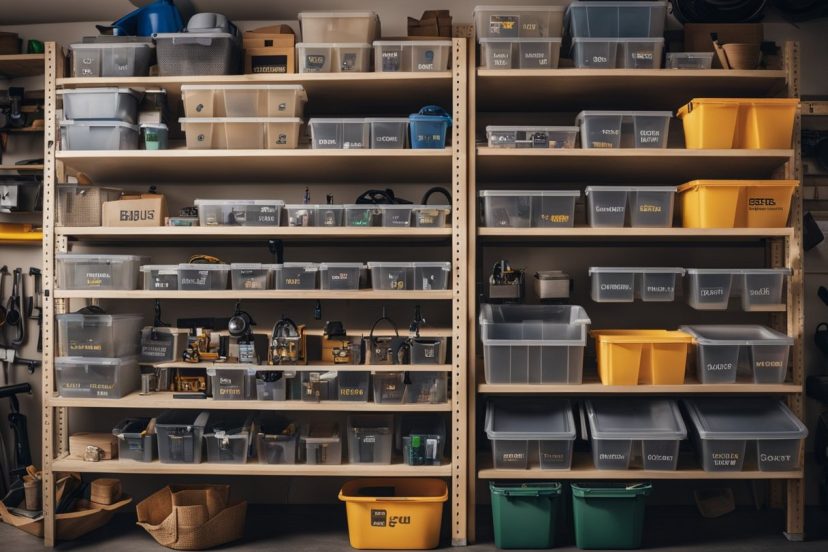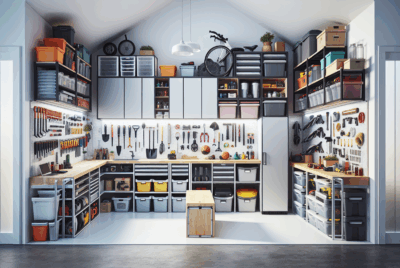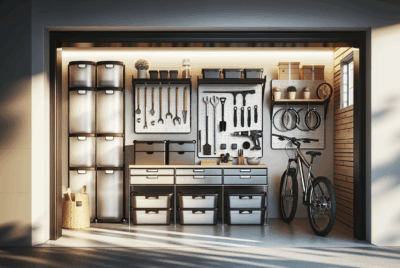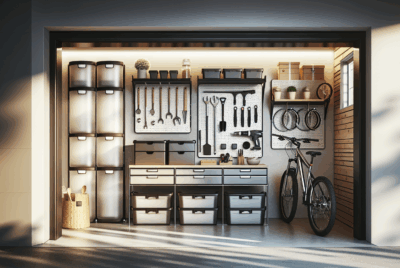How to Organize Garage Clutter: Efficient Tips for a Tidy Space
As an Amazon Associate, I earn from qualifying purchases, at no additional cost to you. Disclaimer
Walking into a messy garage can be overwhelming, but transforming it into a tidy, organized space is easier than you might think.
The key to a clutter-free garage is using wall-mounted shelves, baskets, and hooks to maximize storage space. This strategy not only helps keep the floor clear but also makes finding items much more straightforward.

When tackling the chaos, I start by throwing out trash like broken items or unused boxes. This step clears out unnecessary clutter and sets the stage for more effective organizing.
Using clear plastic bins with labels can further simplify the process, as everything has its designated spot.
Consider what needs to be stored and how often I use these items to find the best solution.
Placing frequently used tools within easy reach makes them accessible, while seasonal or less-used items can be stored higher up. The journey to a neat and usable garage begins with strategic organizing.
Assessing Your Garage’s Potential
Organizing a garage can be a big task, but taking the time to evaluate what you have and planning accordingly will help you make the most of your space.
By determining your storage needs and planning the layout, you can turn a cluttered area into a well-organized part of your home.
Determining Storage Needs
The first step I take is identifying what items need storage. This includes tools, sports equipment, seasonal decorations, and any other belongings cluttering the garage.
I list these items and group them by type or usage frequency. For instance, tools might be organized together while holiday decorations could be grouped separately. This way, I know exactly what I need to store and can choose appropriate storage solutions.
Assessing vertical and ceiling space is crucial.
By using shelves, wall hooks, and overhead storage, I can maximize available space. Cabinets and pegboards are great for smaller items. When deciding on storage solutions, I consider durability and accessibility, ensuring frequently used items are easy to reach.
Planning the Layout
Efficient layout planning is key for a clutter-free garage.
First, I map out the space, considering entrances, windows, and access points. This helps me decide where storage units, workbenches, or other features will fit best. Keeping common pathways clear is important for safety and convenience.
I prioritize how I arrange items, placing often-used tools or equipment in easily accessible areas. A workbench near the tool storage can be practical. If I have larger items, like bicycles or lawn equipment, finding a space that doesn’t block pathways is essential. By planning thoughtfully, I can create a functional and efficient garage layout.
Decluttering Strategies
When tackling garage clutter, it’s crucial to focus on smart sorting and careful handling of sentimental items. By approaching each category effectively, I can create a more functional and organized space.
Sorting and Categorizing Items
To start decluttering, I need to sort everything in the garage into categories. This can include tools, sports equipment, and seasonal gear.
By grouping similar items, I make it easier to see what I have. This helps identify duplicates or items I no longer need.
Once organized, it’s important to consider a functional storage system. I can use clear bins or shelves to keep everything in its place. Labeling is vital here; it allows easy access and keeps me from hunting for items later.
Handling Sentimental Items
Sentimental items can be challenging to declutter, but it’s essential for a tidy garage.
First, I evaluate their emotional value and decide if they truly need to be kept. If I choose to keep them, finding a dedicated spot helps ensure they are protected and not mixed with everyday clutter.
Sometimes taking photos of these items can preserve the memories without keeping the physical item. This way, I maintain the memories while freeing up space. By handling sentimental items with care, I can keep the garage organized and still cherish meaningful memories.
Implementing Storage Solutions

Organizing garage clutter effectively involves utilizing vertical space, choosing appropriate shelving, and finding innovative storage solutions for sports and outdoor equipment. These strategies transform cluttered spaces into functional areas.
Maximizing Vertical Space
To make the most of the garage’s vertical space, I recommend installing tall shelving units. This approach not only saves floor space but also increases storage capacity.
Using a pegboard is another great idea; it provides a spot for hanging frequently used tools and accessories. This keeps them visible and easily accessible.
Hooks can hold items like bicycles and ladders, getting them off the ground. Adjustable shelves can accommodate different sizes of storage containers, enhancing versatility. Spaces that often go unused, like above doorways, can hold additional shelving for lightweight items.
Choosing the Right Shelving
Selecting the right shelving is crucial for garage organization.
For durable freestanding shelving, I look for materials like metal or heavy-duty plastic. These materials support heavier items and are resistant to garage conditions.
Open shelving allows for easy access and visibility of stored items, while storage cabinets with doors can hide clutter.
I also consider adjustable shelving systems, which provide flexibility for changing storage needs. Assessing what I plan to store helps determine the best type of shelving. Moving seasonal items to higher shelves keeps them out of the way when not in use.
Utilizing Overhead and Wall Storage
Overhead storage is perfect for keeping larger, rarely used items out of the way. I use ceiling-mounted racks to store things like camping gear or holiday decorations.
This type of storage keeps bulky items off the floor, freeing up space for frequently accessed belongings.
Wall storage, such as track systems with movable hooks, provides adjustable organization options. By aligning these with garage studs, I ensure stability and safety. This setup is ideal for hanging heavier equipment, like garden tools or bicycles, which might otherwise take up floor space or get damaged.
Storage for Sports and Outdoor Equipment
Designing specific zones for sports and outdoor equipment can prevent them from cluttering the garage.
I recommend using bins or storage cabinets for smaller items like balls and gloves, which keeps them together and prevents loss.
For larger equipment, hooks can be used to hang bicycles or skateboards. Installing racks designed for holding fishing rods or ski equipment can further optimize space. Proper use of open and closed storage solutions ensures quick access to what I need, while keeping everything organized and protected.
Optimizing Work and Hobby Areas

In the garage, work and hobby areas are essential for not only efficiency but also for maximizing space. I focus on creating a space that is clutter-free and well-organized with accessible tools and clearly defined zones.
Setting Up a Functional Workbench
The workbench is the centerpiece of any garage workspace. I start by picking a sturdy bench that fits my available space.
Adjustable benches are a great option for different tasks. Adding shelves or drawers beneath the workbench can provide extra storage for smaller tools and supplies, keeping them within reach.
Pegboards are a fantastic addition above the workbench. They allow me to hang frequently used tools, making them easy to locate and freeing up surface space. Organizing items by type and size on the pegboard helps maintain neatness and efficiency in my workspace.
Organizing Tools and Supplies
To keep my tools in order, a labeling system is essential. Labeling toolboxes, bins, and drawers lets me quickly find what I need.
I use clear containers when possible to make identification easier. For small items like screws and nails, compartmentalized boxes keep everything sorted and accessible.
Storing bulky equipment like drills and sanders requires wall mounts or shelving. I install these at a height that’s easy for me to reach, ensuring safety and convenience.
Keeping my workspace tidy is key, so I routinely check and rearrange supplies as needed to maintain organization.
Maintaining Organization

After organizing my garage, it’s crucial to keep the space neat and efficient. Regular cleaning helps prevent clutter from building up again. Reevaluating storage solutions ensures that all items have a perfect spot, making retrieval easy and maintaining order simple.
Regular Cleaning and Maintenance
I need to regularly clean my garage to prevent clutter from reappearing. This means setting aside time once a week or month to clear out any accumulated mess.
I focus on sweeping, dusting, and keeping the floor clear of unnecessary items. Having a set routine helps maintain a clean environment.
A good labeling system is essential for this task. I label everything, from storage bins to shelves, to ensure things return to their rightful places. Clear labels make it easy to find and store items quickly, reducing the chance of misplaced items causing clutter.
Reevaluating Storage Solutions
It’s important for me to review how I store things in my garage. I assess whether the current setup still works for my needs and make adjustments as necessary.
By doing so, I can incorporate new garage organization ideas that better suit my space and lifestyle.
Using vertical storage options like wall-mounted racks or ceiling storage can free up floor space and keep things organized. I often reassess my storage units to ensure they efficiently use available space. This way, I can easily find what I need without turning the garage into a mess.
Frequently Asked Questions

When it comes to organizing garage clutter, effective strategies and creative solutions can make a big difference. I’ll answer some common questions to help you tackle the clutter and make the most of your garage space.
What are the best strategies for decluttering a garage on a tight budget?
Decluttering without spending much is entirely possible. I recommend focusing on reusing and repurposing what you already have.
Using old jars for small items, or cardboard boxes for sorting, can help manage costs. Garage sales or online marketplaces can also be handy for getting organizational tools at lower prices.
Are there any DIY methods for organizing a cluttered garage effectively?
There are several DIY methods you might find useful.
Wall-mounted shelves can create more space on the floor. Pegboards are excellent for hanging tools and keeping them visible. Using bins for grouping items together based on their use can also help keep everything in order.
What items should be included on a garage declutter checklist?
A checklist should cover different categories such as tools, sports gear, seasonal decorations, and cleaning supplies. I find it useful to also note items needing repair or those that can be donated.
This ensures a thorough evaluation of all items, making it easier to decide what stays and what goes.
How can someone categorize their belongings when organizing a garage?
Categorizing items can simplify the process a lot. I suggest dividing belongings by their function or frequency of use.
For example, grouping gardening tools separately from automotive tools is practical. You can also set aside space for frequently used items and store less-used items higher or in the back.
What are some creative ideas for managing clutter in a garage?
Creativity can transform how you see garage organization.
Hanging bikes on the wall frees up ground space, and using transparent storage bins helps identify contents quickly. Creating designated zones for different activities, such as a workbench area or a storage zone, can also effectively manage clutter.
What are the steps to thoroughly clean and declutter a garage?
Thorough cleaning and decluttering require a systematic approach. I start by removing everything to see the space clear.
Sweeping and cleaning surfaces come next. As I sort through items, I decide what to keep, donate, or discard. Then, I organize the remaining items into categories and place them back in the newly cleaned space.




